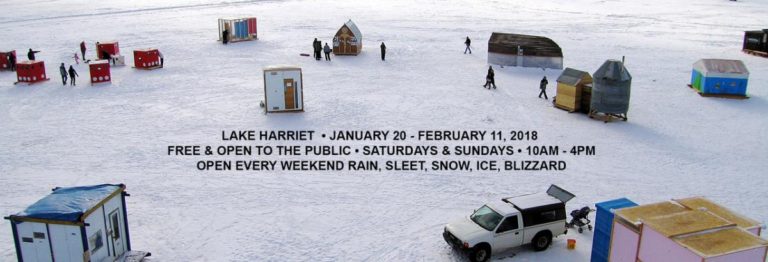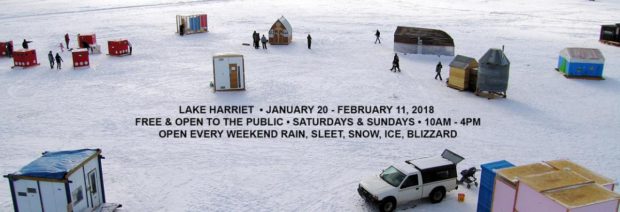
Twenty-one teams of visual artists, fifteen groups of performing artists and one frozen lake are teaming up for another great year of the Art Shanty Projects starting on January 20th at Bde Unma lake, commonly called Lake Harriet. This annual event features one of the most eclectic displays of art and Minnesota community that exists. Artists involved each build Shanties designed after or inspired by the fishing huts we see pop up all over the frozen lakes this time of year and create whatever they want inside the shanty and in the artist-filled lake community. In addition to the art itself, the Art Shanty Project allows and encourages visitors to interact with the artists in a comfortable, low pressure setting. This is the first year the project will be in Minneapolis directly (as opposed to St. Paul or a suburb) and that means there are public transit options, making the event more accessible to low income art lovers or those who are simply without cars. Additionally, Metro Transit is providing FREE rides for the first weekend. Several LGBTQ+ artists are involved this year too, giving Column readers even more to get excited about.
One such artist is Angela North, an oil painter who likes to break out of her box for events like The Art Shanty Projects. This year she’s taking part in The Tomb of the Unknown Minnow, an artistic space full of irreverence and religious iconography who’s basic idea is to pay tribute to the minnows who die in the bait bucket before getting to sacrifice themselves for the greater fishing good. Says North of the Shanty, “ I am very excited about this Shanty and the irreverent sacred nature of the thing. It may convert the worthy fisher people to a new religion.”
She goes on to say “We have already built the shanty. It is beautiful and we are now working on the religious iconography that will adorn the inside and outside, along with an entire lore of the minnows plight and journey into existence.”
Playwright and filmmaker Sami Pfeffer is also creating a Shanty this year, partnering with Anne Grinager (a professional professional timber framer, boat builder, and carpenter) for Phone Valet. Phone Valet offers, according to Pfeffer, “a selection of 16 ‘analog apps’, creatively re-imagined substitutes for functions normally delineated to smartphones. For example, participants are encouraged to embark on a treasure hunt through the Maps app, create a flipbook for YouTube, request a song from on-hand musicians through Spotify, or check out a film camera instead of snapping photos digitally.”
Pfeffer continues, “These ‘apps’ allow participants to be present with each other, and the other Shanties, in new and radical ways. Or rather, in old and radical ways. For example, we live in an age when we can take photographs without asking permission. In fact, we can take photographs without even revealing that we are using a camera. So how does an analog device alter our relationship with our subject?”
If this concept seems familiar, it’s because it did premiere at Northern Spark in 2017. Since Northern Spark runs just one night in the summer though, the project has been tweaked due to weather, sunlight, and the learning process that debuting a new artwork entails. The original Phone Valet insisted that people part with their phones for the duration of checking out the project, something that made many people feel anxious or ashamed for various reasons. While Pfeffer is directly interested in shame and vulnerability in art, that doesn’t mean they want participants to feel shame while engaging in the art they create, so actually valet-ing one’s phone has been cut from the project. Phone Valet is using a smaller Shanty than some other projects, providing an intimate encounter with the experiences we took for granted before smart phones.
In person engagement is a common theme in this year Art Shanty Project among queer artists. Real life couple Nat Locke and Ana Begej are creating Team Engine where they will facilitate cooperative games. Says Locke “I actually consider myself an educator first and foremost, but I can include education in a broad definition of what art is. I like to design experiences. In the absence of time and resources for creating the kinds of experiences people usually think of, I’ve found that games can help us learn and experience quite a lot in groups so they’ve sort of become my educational medium of choice. I’m specifically interested in what we can learn about ourselves and how we work with others by playing together.” Those games include racing on four-person skis and trying to find unknown game partners throughout the bustling lake. Locke adds “The Team Engine is sort of the fusion of our love of Art Shanties and our desire to bring these games to a wider audience. Hopefully we’ll get to use it off the ice in the coming years, too!”
Several other LGBTQ+ artists are involved, including Jeremy Bue, Claire Swanback and Ari Baum-Hommes, to name a few. This means that no matter where you are on the ice, you’ll likely run into some friendly faces from the larger queer community, and know that your viewpoint is represented somewhere. Another exciting, inclusive feature this year is the Welcome Hut, created completely by University of Minnesota College of Design students. This part warming hut, part information hub run by students means that in addition to the seasoned artists and educators we’ve talked about, new and emerging artists have a substantial hand in making this event happen. Says event organizer Lacey Prpić Hedtke, “I love being a part of this project because I see how much of an impact the shanties have on artists, performers, volunteers, and visitors. It happens at a time of winter where people are starting to get stir crazy, and every year after visiting the shanties I’ve thought, ‘Oh yeah, this is why I live in Minneapolis–we’ve got the coolest public art around!’ It’s a great chance for people to get outside in the winter, onto a frozen lake. The majority of people who attend the event don’t usually attend art events. I love that it’s accessible to people in so many ways.”
The Art Shanties take over Bde Unma/Lake Harriet near the Bandshell starting on January 20th-February 11th, 2018. The On Ice Program is open Saturdays and Sundays from 10am-4pm during those weeks. The Art Shanty Projects On Ice program is public art; that means free to all. The Shanties do accept donations on the ice, and the overall project has a new membership program people can join. You can find out more about that program as well as the Art Shanties themselves on the Project’s website.
